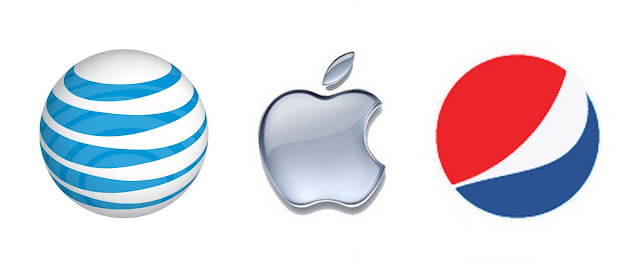What is all the discussion about? For starters it has nothing to do with cattle or ranching (thankfully). It is about connecting -- connecting people to products, people to people, products to organizations, habits to businesses -- virtually every cognitive association you can imagine. Most often it is in terms of capturing the elusive "market share" and how to captivate the audience that you seek for your business or organization. Nonetheless, what makes a brand and why does the logo matter?
In many ways a logo is a brand, or the line between the two is evanescent. The logos below illustrate three different companies with three different focuses (utility service, consumer electronics, food/beverage consumption) each with very strong brand connections.
What these examples further demonstrate is that each brand is more subjective than its logo. What are the kinds of things that you think about Apple when you see its logo? Expensive products? High design? Mock turtlenecks? What are the kinds of things you think about AT&T? Terrible cellular coverage? Out of date phone company?
In the last 10 years, with the acceleration of communication media and the globalization of information (also called "flattening") there are exponentially more bits, bytes, and blogs (shameless plug) vying for your attention. Therefore organizations are attempting to more easily differentiate themselves from the white noise and be identifiable. Branding is about identity; how do I become recognizable? All of the logos below are circles, yet many are immediately distinguishable as to their company and brand.
"Enough already," you say, "so when does a logo become a brand?"
Well that is not quite the point. A logo needs to reinforce a brand and be a part of a comprehensive brand strategy that makes it as clear as possible what the brand is. This is extremely difficult because of how many variables exist in the equation. For instance, if you are CBS, you have an interest in creating a brand identity to both senior citizens and 30-something adults (think "Murder She Wrote" and "How I Met Your Mother"). How can you appeal to one demographic without alienating the other? The answer would be to create a brand that is identifiable because of its interesting programming that appeals to many different demographics. Even so, there is no assurance that your message will be received correctly. If Charter Communications is having issues transmitting TV signals, and the elderly woman in Pennsylvania cannot watch her show that she has been waiting all week for, will she be upset at Charter or CBS?
While you cannot control everything, there are several key aspects to branding and ensuring that your message is coming across as intended:
- Design Matters: our world today is highly visual and attention paid to design will matter for the uniqueness of a brand.
- Consistency is Key: consistency in logo, trademark, message, slogan, etc. All work together to reinforce the brand.
- Simplicity: this may be difficult to achieve, but many of the most successful brands are simple and understated while their business may be diverse and global (e.g. Nike, Target)
Of course this only applies if you want to stand out from the crowd. However, judging from the narcissism of our Millenial Generation this should be nothing out of the ordinary. Happy branding!


No comments:
Post a Comment